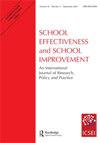三级模型中从学生亚群体成长角度评估学校的方法比较
IF 2.8
3区 教育学
Q1 EDUCATION & EDUCATIONAL RESEARCH
引用次数: 0
摘要
摘要尽管人们已经认识到,学校内的学生群体可能会有不同的结果,但对亚群体结果的审查对研究人员和政策制定者来说是一个挑战。它使分析程序复杂化,尤其是当小组中每个学校的学生人数很少时。我们探索了五种替代方案,即应用三级多层次成长模型框架,使用跟踪阅读成绩的大型纵向数据库来检查选定的学生(残疾学生)的学校水平成绩。替代方案在仅使用亚组或所有学生数据、使用学生水平预测因子以及将学生或学校水平的结果与学校有效性指数联系起来的方法方面各不相同。备选方案之间的相关性从.57到.99表明,选择如何得出一个亚组的学校水平结果,会对学校对该亚组的有效性产生推论。研究人员的假设和可用数据应指导方法的选择。本文章由计算机程序翻译,如有差异,请以英文原文为准。
A comparison of methods for evaluating schools with respect to growth of students in subpopulations in three-level models
ABSTRACT Although there is recognition that there may be differential outcomes for groups of students within schools, examination of outcomes for subgroups presents challenges to researchers and policymakers. It complicates analytic procedures, particularly when the number of students per school in the subgroup is small. We explored five alternatives for applying a three-level multilevel growth modeling framework to examine school-level achievement for a select subgroup of students (students with disabilities) using a large longitudinal database tracking reading achievement. The alternatives vary in terms of use of subgroup only or all student data, use of student-level predictors, and method of linking student or school-level outcomes to school effectiveness indices. Correlations from .57 to .99 among alternatives suggest the choice of how to derive school-level outcomes for a subgroup has consequences for inferences about the school’s effectiveness with the subgroup. Researchers’ assumptions and data available should guide the selection of an approach.
求助全文
通过发布文献求助,成功后即可免费获取论文全文。
去求助
来源期刊

School Effectiveness and School Improvement
EDUCATION & EDUCATIONAL RESEARCH-
CiteScore
6.60
自引率
0.00%
发文量
23
期刊介绍:
School Effectiveness and School Improvement presents information on educational effectiveness, practice and policy-making across primary, secondary and higher education. The Editors believe that the educational progress of all students, regardless of family background and economic status, is the key indicator of effectiveness and improvement in schools. The journal strives to explore this idea with manuscripts that cover a range of subjects within the area of educational effectiveness at the classroom, school or system level, including, but not limited to: •Effective pedagogy •Classroom climate •School ethos and leadership •School improvement and reform programmes •Systemwide policy and reform
 求助内容:
求助内容: 应助结果提醒方式:
应助结果提醒方式:


